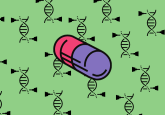Microbiome digital twins enable disease prediction in infants

Researchers at the University of Chicago (IL, US) have unveiled an AI tool capable of predicting neurodevelopmental deficits in infants by modeling their gut microbiome. This innovative approach, leveraging a “digital twin” of the microbiome, signifies a major leap in understanding and potentially intervening in the health and development of infants at risk.
The human gut microbiome, a complex ecosystem of microorganisms, plays a crucial role in our overall health. It impacts everything from digestion to immune system function. In infants, the balance of this microbiome is essential for healthy development. However, imbalances or dysbiosis can lead to serious health issues, including gastrointestinal diseases and neurodevelopmental disorders. Traditionally, studying the intricate interactions within the microbiome to understand these risks has been a slow and laborious process.
Enter the team at the University of Chicago, who have developed an AI tool dubbed Q-net. This tool creates a virtual “digital twin” of the infant microbiome, accurately modeling how microbial species in the gut evolve over time. By analyzing fecal samples from preterm infants in neonatal intensive care units, Q-net can identify infants at high risk for cognitive deficits with a remarkable 76% accuracy.
Ishanu Chattopadhyay, Assistant Professor of Medicine at UChicago (IL, US) and senior author of the study, emphasized the limitations of traditional snapshot analyses of the microbiome. “In a preterm infant, the microbiome is constantly changing and maturing,” Chattopadhyay explained. “With Q-net, we’re able to model these dynamic interactions and identify potential risks much earlier.”
The digital twin concept, merging disciplines like computer science and biology, offers a faster, more scalable way to explore microbial interactions. Conventional methods could take centuries to test all possible bacterial interactions within a typical colony. Q-net, however, can rapidly identify interactions of interest and their potential links to health outcomes.
Validated using data from both the University of Chicago’s Comer Children’s Hospital (IL, US) and Beth Israel Deaconess Medical Center in Boston (MA, US), Q-net not only predicts developmental risks but also suggests interventions. Restoring certain bacterial species, for example, could mitigate developmental risks for about 45% of the studied infants. However, the research team warns against indiscriminate use of probiotics, stressing the importance of precision and timing in interventions.
Beyond infant health, the potential applications of Q-net are vast, ranging from tracking virus evolution to analyzing social phenomena. “If you have a large amount of data, this system can uncover the underlying connections,” Chattopadhyay said, highlighting the AI’s versatility and sensitivity.
The study represents a significant step forward in using AI to understand and improve infant health outcomes, with implications that reach far beyond neonatal intensive care units investigated in this study.



